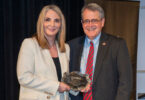The University of Georgia will sponsor additional research to learn more about the lives of the individuals whose gravesites were discovered during the construction of the Baldwin Hall expansion. The work is two-pronged, consisting of further DNA analysis of the remains and a historical mapping study to learn more about the physical environment in which the individuals likely lived and worked.
Following the discovery of the remains in November 2015, the university immediately consulted with the State Archaeologist’s Office for guidance. The university then commissioned a team of faculty, graduate students and undergraduate students in the anthropology department to explore ancestry, age, sex and other characteristics of the individuals. About one-third of the 105 gravesites yielded samples suitable for DNA analysis, and the researchers found that the vast majority of these individuals were of maternal African descent.
UGA Vice President for Research David Lee solicited further faculty input following the reinterment of the remains earlier this spring. He also consulted with leaders of the local African-American community.
“The university is committed to building upon the preliminary research and learning more about the lives of the men, women and children—who were likely slaves or former slaves, given the time period—whose remains were found adjacent to the Old Athens Cemetery on the Baldwin Hall site,” said Lee. “These additional research efforts will help us in that pursuit.”
The Office of Research will coordinate the next steps as follows:
1. The university will commission further DNA analysis to be conducted by researchers at the University of Texas at Austin who specialize in the analysis of ancient DNA.
These researchers already have been engaged with UGA assistant professor Laurie Reitsema in the first phase of research, which provided information only about maternal ancestry. The additional analysis will provide information about paternal ancestry and, thus, paint a comprehensive picture of ancestral origin.
It also will confirm the sex of the individuals and determine whether any of those buried on the site were related to one another. This detailed analysis should be completed within the coming year.
2. The supplemental DNA information gained through Step 1 could provide the reference materials needed to determine if any living community members are related to the individuals whose remains were found at the Baldwin Hall site.
The Office of Research is exploring the means by which to make this option available, as economically as possible, to local citizens wishing to pursue a possible DNA linkage.
3. Professor Marguerite Madden, director of UGA’s Center for Geospatial Research, will lead a team to create a dynamic time-series visualization of the cultural and natural landscape surrounding Baldwin Hall from the 1800s to the present. This project will incorporate historic maps, aerial photographs, satellite images and drone video to reveal more about the environment in which the individuals buried on the Baldwin Hall site lived and worked.
In addition, the research will document the evolution of the cemetery and campus to present day. Most of this research will be done over the next several months.
Madden’s efforts will complement those of Southeastern Archaeological Services Inc., which will be conducting archival research and mapping services using ground-penetrating radar to identify, to the extent possible via this technology, the boundaries of the Old Athens Cemetery. Southeastern’s mapping data will be included in the final report on the Baldwin Hall site that is required for submittal by the Office of University Architects to the State Archaeologist’s Office.




